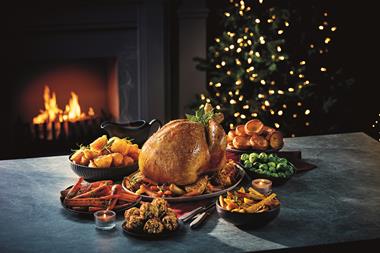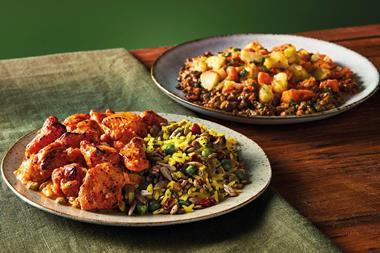Consumers are munching away from traditional biccies and cakes in favour of more indulgent or healthier biscuits, says Helen Gregory
Look inside most biscuit barrels these days and you’re more likely to find cookies with chocolate and pecans or a low-fat cereal bar than a humble digestive.
Consumers increasingly want a treat or to feel good about themselves, which means traditional biscuits are losing share - but it’s something manufacturers are encouraging because healthy and indulgent products can command a premium.
The biscuit market is worth £1.74bn [TNS 52 w/e September 11, 2005] and is growing at 4.1% year-on-year. Chocolate biscuits - led by Kit Kat and McVitie’s Chocolate Digestives - is the biggest sector, worth £384m and down 0.8%, but healthier biscuits aren’t far behind, worth £301m and up 13.6%.
Everyday treats are on the rise, but bog-standard biscuits are down 2.5% at £235m. “Ordinary sweet biscuits have suffered as people have moved into healthy products or traded up,” admits Northern Foods’ marketing and research and development director, Mike Driver.
Manufacturers such as Fox’s Biscuits and Burton’s Foods are coming up with new varieties and formats such as tubs, which many consumers find more exciting and convenient. Burton’s Foods this year launched mini versions of its Viscount range, adding a new praline flavour, moving from children’s lunchboxes to adult ones.
There is also increasing innovation in savoury biscuits, with more premium and snacking products growing their fan base.
Manufacturers are also trying to drive consumption by encouraging retailers to promote eating occasions. Both Sainsbury and Tesco merchandise chocolate biscuit bars and kids’ biscuits together as lunchbox fare.
Says Mark Sugden, head of customer marketing at United Biscuits: “We’re working with retailers to find better signposts and create a clearer fixture because consumers shop by occasion. By demarcating segments you can encourage people to purchase from them.”
Promoting healthy credentials can also act as a stimulant, and the Biscuit, Cake, Chocolate and Confectionery Association says producers are addressing the diet and health debate by working with the FSA, providing extra labelling information and showing guideline daily amounts on packs and company websites.
Although the health debate means biscuits aren’t always first choice for a between- meal treat, cakes tend to have a more wholesome image. “Clearly the major issue is health, which is beginning to affect other categories,” says Martin Wiltshire, marketing controller at Memory Lane Cakes. “Cakes are an indulgence, but fortunately have a number of positive attributes: they are a permissible indulgence and often shared, which helps reduce guilt and provides further permission to purchase and consume.”
Market researcher BMRB TGI reports the cake market - worth £960m and up 4.4% [TNS 52 w/e September 11, 2005] - is
skewed by age, with many heavy consumers (people who eat cakes twice a week or more) aged 65 or over.
However, individually wrapped items are bringing in younger consumers, as are products such as flapjacks, popular with young and upmarket consumers who have helped boost their share to 2.8% - up a whopping 114%.
Teatime accounts for 28% of all in-home occasions, says TNS. And while consumers are choosing fewer of the modern formats such as cake bars and slices, plumping for small cakes, tarts, muffins and fruit loaves, research shows that, overall, more cake is eaten on Monday - a good indication it’s used by many to cheer themselves up.
Cakes are increasingly eaten away from home, as an office treat or to avoid sharing with or being seen by children. Sarah Lewis, category marketing manager for bakery at The Co-operative Group, says consumers are buying cake in place of confectionery as part of lunch or a sweet treat during the day. “Eat now is a major growth area and opportunities exist to further maximise its growth,” she says.
Rebecca Allinson, marketing manager at McVitie’s Cakes, adds: “Convenience is a key trend although individually wrapped products are now accepted, so we’re looking at things such as shelf-ready packaging to make it easier for the retailer to merchandise.”
Look inside most biscuit barrels these days and you’re more likely to find cookies with chocolate and pecans or a low-fat cereal bar than a humble digestive.
Consumers increasingly want a treat or to feel good about themselves, which means traditional biscuits are losing share - but it’s something manufacturers are encouraging because healthy and indulgent products can command a premium.
The biscuit market is worth £1.74bn [TNS 52 w/e September 11, 2005] and is growing at 4.1% year-on-year. Chocolate biscuits - led by Kit Kat and McVitie’s Chocolate Digestives - is the biggest sector, worth £384m and down 0.8%, but healthier biscuits aren’t far behind, worth £301m and up 13.6%.
Everyday treats are on the rise, but bog-standard biscuits are down 2.5% at £235m. “Ordinary sweet biscuits have suffered as people have moved into healthy products or traded up,” admits Northern Foods’ marketing and research and development director, Mike Driver.
Manufacturers such as Fox’s Biscuits and Burton’s Foods are coming up with new varieties and formats such as tubs, which many consumers find more exciting and convenient. Burton’s Foods this year launched mini versions of its Viscount range, adding a new praline flavour, moving from children’s lunchboxes to adult ones.
There is also increasing innovation in savoury biscuits, with more premium and snacking products growing their fan base.
Manufacturers are also trying to drive consumption by encouraging retailers to promote eating occasions. Both Sainsbury and Tesco merchandise chocolate biscuit bars and kids’ biscuits together as lunchbox fare.
Says Mark Sugden, head of customer marketing at United Biscuits: “We’re working with retailers to find better signposts and create a clearer fixture because consumers shop by occasion. By demarcating segments you can encourage people to purchase from them.”
Promoting healthy credentials can also act as a stimulant, and the Biscuit, Cake, Chocolate and Confectionery Association says producers are addressing the diet and health debate by working with the FSA, providing extra labelling information and showing guideline daily amounts on packs and company websites.
Although the health debate means biscuits aren’t always first choice for a between- meal treat, cakes tend to have a more wholesome image. “Clearly the major issue is health, which is beginning to affect other categories,” says Martin Wiltshire, marketing controller at Memory Lane Cakes. “Cakes are an indulgence, but fortunately have a number of positive attributes: they are a permissible indulgence and often shared, which helps reduce guilt and provides further permission to purchase and consume.”
Market researcher BMRB TGI reports the cake market - worth £960m and up 4.4% [TNS 52 w/e September 11, 2005] - is
skewed by age, with many heavy consumers (people who eat cakes twice a week or more) aged 65 or over.
However, individually wrapped items are bringing in younger consumers, as are products such as flapjacks, popular with young and upmarket consumers who have helped boost their share to 2.8% - up a whopping 114%.
Teatime accounts for 28% of all in-home occasions, says TNS. And while consumers are choosing fewer of the modern formats such as cake bars and slices, plumping for small cakes, tarts, muffins and fruit loaves, research shows that, overall, more cake is eaten on Monday - a good indication it’s used by many to cheer themselves up.
Cakes are increasingly eaten away from home, as an office treat or to avoid sharing with or being seen by children. Sarah Lewis, category marketing manager for bakery at The Co-operative Group, says consumers are buying cake in place of confectionery as part of lunch or a sweet treat during the day. “Eat now is a major growth area and opportunities exist to further maximise its growth,” she says.
Rebecca Allinson, marketing manager at McVitie’s Cakes, adds: “Convenience is a key trend although individually wrapped products are now accepted, so we’re looking at things such as shelf-ready packaging to make it easier for the retailer to merchandise.”













No comments yet